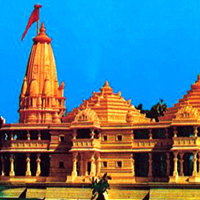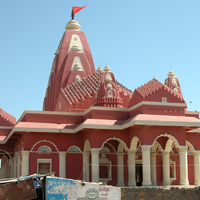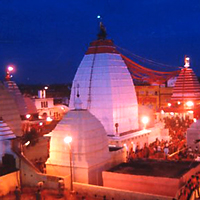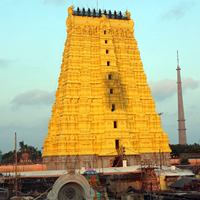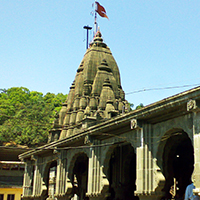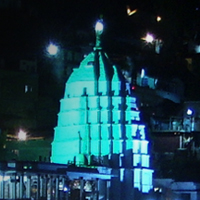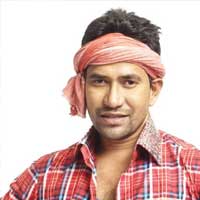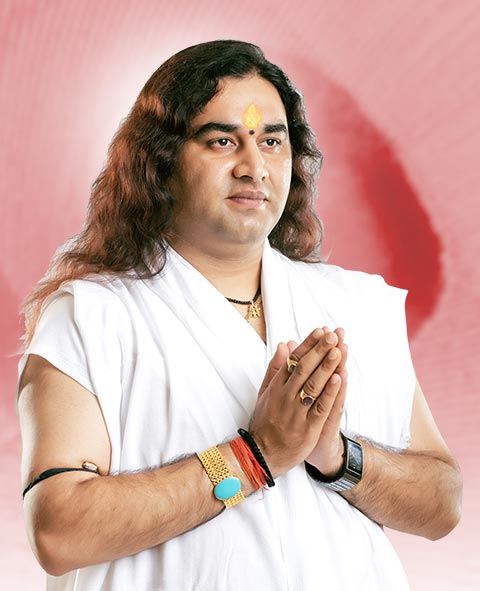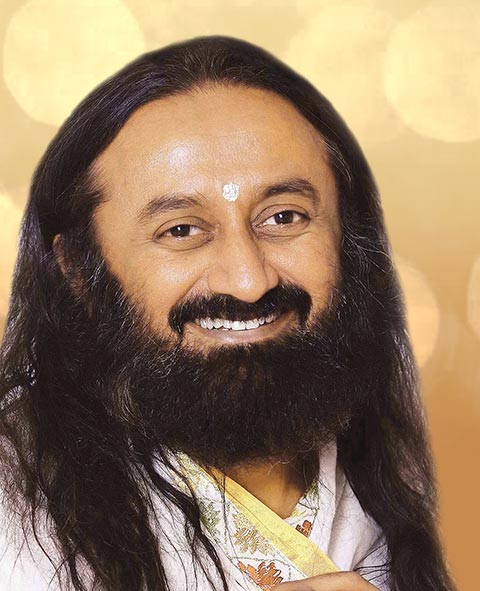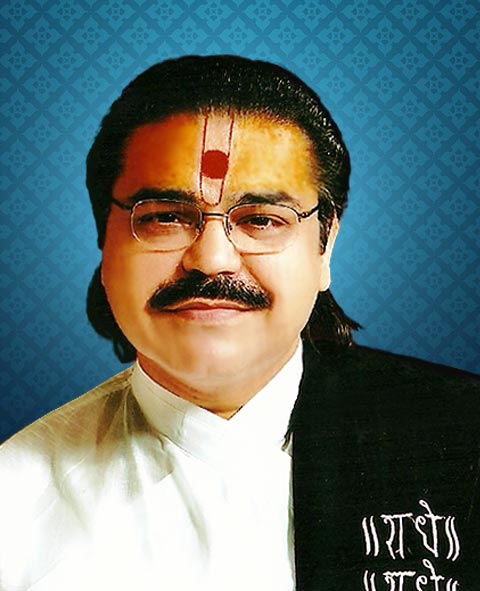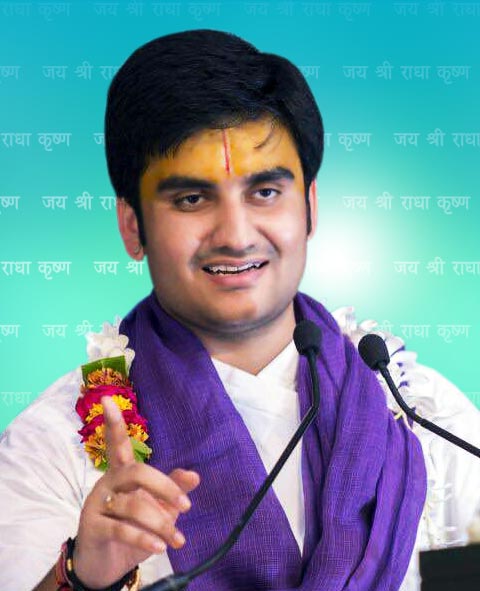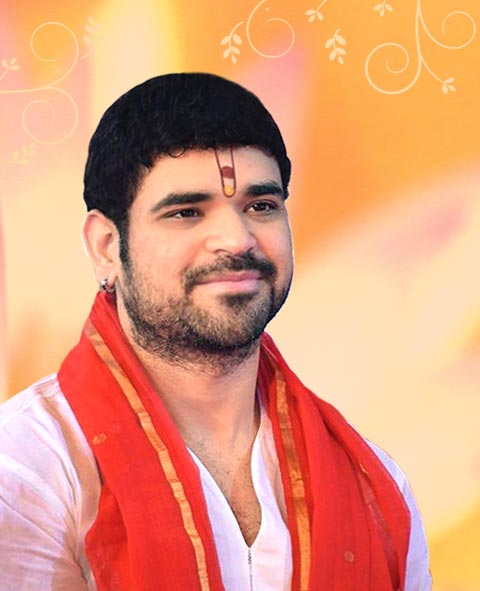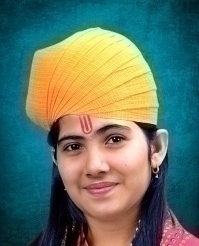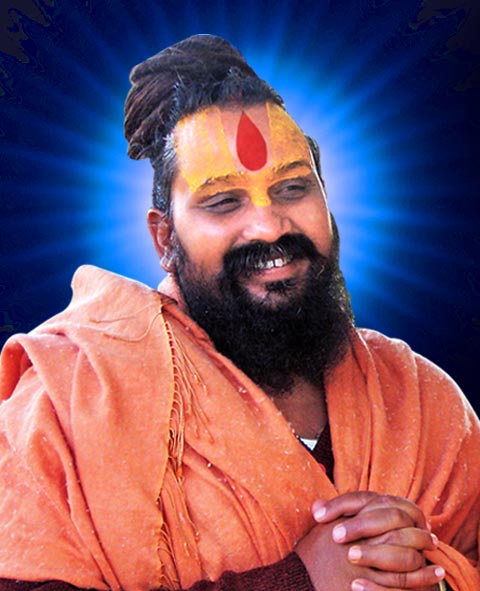Browse By Tample

Sri Radha Raman temple
Sri Radha Raman .
THE TEMPLE
The self manifested deity out of the Saligram Shila, over 500 years old heritage temple where standards of worship are highest in Vrindavan. Radha Raman Temple was established by Gopal Bhatta Goswami. He is one of the six Goswamis of Vrindavan who followed the principles of Sri Chaitanya Mahaprabhu strictly. This beautiful Deity is self-manifested from a saligram sila and has a mystic smile on his face. Sri Radha Ramans Appearance Place is in the Radha-Raman Temple, next to the samadhi of Gopala Bhatta. It is said that there are markings of discs on the Deitys back and feet. The Deity of Radha-Raman is around 30cm (1 foot) tall. Gopal Bhatta Goswamis other saligram-shilas are also worshiped on the altar here. Radha-Ramanji is one of the few original Deities of the Goswamis still in Vrindavan. The standard of worship in this temple is very high. There is no Deity of Radha in this temple. The name of Radharani is worshiped in this temple, because according to scriptures the name and the person are considered non-different. There is a golden plate next to Krishna, which has the name of Radharani engraved into it.
A Deity of Radharani is not worshiped in this temple because the Deity of Radha-Raman is self-manifested and there was no Deity of Radharani self-manifested. The present temple was built in 1826 at the cost of 80 thousand rupees by Shah Behari Lallji from Lucknow, the grandfather of Shah Kundan Lall and Shah Fundan Lall, who built the Shahji Temple. Sri Chaitanya Mahaprabhus kaupina (cloth) and asana (seat), which Gopal Bhatta Goswami brought from Jagannath Puri, are also in this temple. The asana is black wood and is about 31cm (12) by 25cm (10). They are brought out to be seen by the public for six days a year. They can be seen on Gaura Purnima, the appearance day of Radha Raman, the actual day and day after the disappearance of Gopal Bhatta Goswami, Janmasthami and Nandotsava (the day after Janmasthami). There is a daily abhiseka of the asana with Yamuna water. There is no decay of the asana or any cracks, even after 450 years. For the raja bhoga offering, Radha Ramans pujaris first offer all of the bhoga (food) to Radha-Raman and the shalagrama shilas, and then they make a second offering to Srimati Radharani, and then a third offering for Gopal Bhatta Goswami. There are not three different plates, but the same plate is offered in the order above. The fires for cooking in the temple kitchen have been burning continuously for over 440 years, since the Deity was installed. This is so no foreign elements, such as matches, are used for ignition purposes. Before the present temple was built, there was another temple at the same place that is now the kitchen and prasadam area for the present temple.
Gopal Bhatta Goswamis Samadhi is to the left, after you enter the first gate from the street into the temple compound. After entering the temple compound you turn left and walk fifty metres (150 ft). He passed away at the age of 85, in 1596, exactly 100 years after the appearance of Lord Chaitanya. His disappearance day is celebrated in the month of Shravana (July-Aug) on the Shukla Panchami (5th) day. There are also smaller samadhis here of the previous sevaits (priests) of Radha-Raman. There is regular worship at this samadhi. Daily bhajans and kirtanas are chanted and the Srimad Bhagavatam is recited. Twice a day a full plate of Radha-Ramans maha-prasada is offered. They also offer him fresh drinking water. In a separate kitchen, five bhoga (food) offerings are prepared and offered to Gopal Bhatta Goswami. After the offerings, five aratis are performed. After the last arati of the day, Radha Ramans pujari give Radha-Ramans maha flower garlands to Gopal Bhatta Goswami. In the area of the present Radha-Raman Temple, there used to be a lake connected to the Yamuna River.
TEMPLE HISTORY
After Sri Caitanya Mahaprabhu’s disappearance Gopala Bhatta Gosvami felt intense separation from the Lord. To relieve his devotee, the Lord instructed Gopala Bhatta in a dream :”If you want my darsan then make a trip to Nepal”.
In Nepal, Gopala Bhatta bathed in the famous Kali-Gandaki River. Upon dipping his waterpot in the river, he was surprised to see several Shaligrama Shilas enter his pot. He dropped the shilas back into the river, but the shilas re-entered his pot when he refilled it.
After emptying and refilling his waterpot for the third time, Gopala Bhatta Gosvami found twelve Shaligrama shilas sitting there. Thinking this must be the Lords mercy, he kept all the shilas and returned to Vrndavana.
Sri Gopala Bhatta Gosvami used to worship twelve Shaligram silas. Wherever he would go he would bring them with him in a piece of cloth tied at the corner. One day a wealthy man (Seth) came to Vrndavana and offered Gopala Bhatta a variety of clothing and ornaments for his Shaligrams. Being very impressed with the Gosvami he wanted his darshan and to render some service which he presented in the form of some valuable cloths and ornaments. However, Gopala Bhatta couldn’t use these for his round-shaped Shaligrams, so he advised the donor to give the Deity decorations to someone else, but the Seth insisted. Gopala Bhatta kept the cloths and ornaments with his shilas. While Gopala Bhatta Gosvami was absorbed in remembering how the half-man, half-lion form of the Supreme Lord had manifested from the pillar in Hiranyakasipu’s palace, he prayed in transcendental lamentation to the Lord:
“Oh my Lord, you are very merciful and always fulfill the desires of your devotees. I wish to serve you in your form, having arms and legs and blissful smiling face, with lotus eyes…. If I had a Deity then I would be able to decorate Him so nicely with these clothes and ornaments.”

In the evening after offering some bhoga and arotika to his Shalagram shilas, Gopala Bhatta put them to rest, covering them with a wicker basket. Late in the night, Gopala Bhatta took a little rest and then, in the early morning went to take bath in the Yamuna river. Returning from his bath, he uncovered the Shalagramas in order to render the puja for Them, and saw amongst Them a Deity of Krishna playing the flute. There were now eleven shilas and this Deity. The “Damodara shila”, had manifested as the beautiful three-fold bending form of tri-bhangananda-krishna. Floating in the ocean of ecstasy, he fell to the ground in order to offer his dandavats and then recited various prayers and hymns. This wonderful event of the appearance day of Radha-raman happened on the day after Sri Nrisimha Chaturdasi, and is celebrated on that day accordingly. That day they offer 500 liters of milk for the Lord’s pleasure and many other sweets and different things. The Radha-raman temple has the highest standard of Deity worship in all of Vraj.
When Rupa and Sanatana Gosvamis as well as many other devotees received news of this miraculous event they came running to see the Lord. Gazing on the Lord’s transcendental form, which bewildered all the living entities of the many various planets, they all bathed Him with their tears. This Deity whom the Gosvamis named, “Sri Radha-raman Deva” made His appearance on the full moon day of Vaisakha in the year 1542. Except for Vrindadevi, Sri Radha-Ramanaji is the only one of the original Deities of Vrindavana who never left to go to Jaipur. Sri Sri Radha-raman-ji is still being worshipped in Vrindavana near Nidhuban kunj in the compound of the temple.
The Deity is called Radha-raman although physically there is no apparent Deity of Radha there. As one can see from the picture at the top of this page, that to the right of the picture (to Ramanji’s left) is a place setting for Srimati Radhika. In this way the pujaris worship Sri Radha and Ramanji together.
Sri Radha-ramana Deva, unlike other Deities, has very intricate features, including fingernails and even teeth. On the back side of His body parts of the original Shalagram shila from which He manifested Himself can be seen.
IMPORTANT FESTIVALS
RAMA NAVAMI
The appearance day of Lord Ramachandra, also called Brahmotsava, in the month of Chaitra (March/April).
CHANDAN YATRA
The Deities are covered completely with chandan (sandalwood paste) which provides relief from the scorching summer heat in the month of Jyestha (May/June). Chandan Yatra continues with the small Deities for 21 days.
JHULAN YATRA
Swing festival at the beginning of the rainy season in Shravan (July/August). The small Deities are brought out into the temple courtyard on a beautiful gold-plated, solid teakwood swing. Around the swing is Phool Bungalow (flower house) for the Lord’s pleasure.
BALARAM PURNIMA
Appearance day of Balaramji, Krishna’s elder brother, celebrated at the end of Shravan.
SRI KRISHNA JANMASTAMI
Appearance day of Sri Krishna celebrated in the month of Bhadra (August/September). From early morning until after midnight lakhs of pilgrims take darshan of Sri Krishna. Before midnight there is Maha Abhishek of Sri Krishna on the altar and then a fabulous bhoga offering and aratika take place at midnight.
RADHASTAMI
Appearance day of Shrimati Radharani held fifteen days after Sri Krishna Janmashtami. The day is celebrated by a half-day fast, abhishek and wonderful feast.
KARTIKA
The month of Kartika, also known as Damodara (October / November), attracts the most devotee visitors from around the world. For the entire month, devotees offer lamps to the Deities in the evening and chant the glories of the Lord’s special Kartika childhood pastimes. Highlights of the month are Diwali, Govardhan Puja. Vraja Mandala parikrama tours the twelve forests of Vrindavan during the month of Kartika.
NITYANANDA TRAYODASI
Appearance day of Sri Nityananda Prabhu in Magh (February/March).
VASANT PANCAMI
First day of spring in Magh (January/February). On this day the Deities are dressed in yellow outfits complemented by beautiful flower decorations. This is also the beginning of Holi in Vraja, which continues till Gaura Purnima. Holi celebrations of throwing colored powders proceed from one village to another, ending in Vrindavan on Gaura Purnima.
GAURA PURNIMA
Appearance day of Sri Chaitanya Mahaprabhu in Phalguna (February/March). On this auspicious day, there is fasting until moonrise, abhishek and a beautiful new outfit offered to the Lord. This day also marks the last day of the famous Holi celebrations in Vrindavan.
Sevā of Radharaman involves service to the deity throughout the day by priests who are mindful of his eternal, daily activities, which are considered to take place at specific times during the eight periods or watches into which the day is divided. They wake him up, prepare him for darshan, bathe and dress him, feed him, and honor him with rituals that are collectively called puja (worship). The rituals honoring the deity are precise and in principle unalterable, constituting a logic of relationship between the person conducting the puja and the deity. The puja conducted in public is called arati—a term that refers to the circling of lighted wicks in front of the deity, a token of the devotion being offered, but is commonly taken to mean the public portion of the priests’ attendance on him with offerings of other items as well.

The temple is opened before dawn; the first arati, mangala arati, is at 4:45 or 5:00 A.M. in the summer, 5:30 A.M. in winter. The temple is locked at night, and the key is in the safekeeping of the Goswami who is in charge of sevā at the time. Sometimes, something goes awry. One summer morning in 1994, for example, the key could not be found.
When it was finally located, it would not turn in the keyhole. Not until 6:00 or 7:00 A.M. were the Goswamis able to enter and prepare Radharaman for darshan. The whole compound was abuzz, of course, and it was rumored that for the rest of the day Radharaman ji had a happy grin on his face.10 Normally, the first darshan of the day is announced by the ringing of the temple bell. Soon after the Goswamis have awakened Radharaman and prepared him for darshan, there is a short peal in the predawn darkness and five minutes later, a clanging that continues throughout the service. On most mornings, perhaps a dozen neighbors have gathered when the bell first rings; perhaps two dozen more come in after the first ringing, and more enter as the service proceeds. Many are women who have already taken their morning baths and come with their little pots of Yamuna water that they will use for their own devotions at home.
Many bring little wicks soaked in oil to light on the edge of the platform before the deity; most toss small coins or flowers onto the platform during the service. Outside the temple sits a man who sells flower garlands for a rupee or two, which some devotees buy and place on a low stool at the front of the platform as an offering to Radharaman. Others bring tulasi leaves to place there.
Before the doors to the inner sanctum are opened, many of the people who come to greet him circumambulate the inner sanctum, walking behind the temple (keeping it to their right), entering a back door on the northwest corner of the temple, walking clockwise around the courtyard inside the temple and out the main entrance, and turning right again to go behind the temple. Each has a specific number of times he or she customarily goes around, repeating a mantra all the while. Meanwhile, the men who have gathered inside sit on the checkered marble floor and sing bhajans—chants evoking Krishna and Radha—with the harmonium player in the rear portico. The women tend to sit within the shelter of the porticos. When movement on the platform indicates that the curtains in front of the deity are about to be opened, all stand up and move to the front of the court, and there is a certain dramatic tension as people wait for the curtain to be opened so they can see the deity, awakened for the new day.
At Radharaman’s first darshan he is still wearing his night clothes, including in the winter a little flat-topped cap that covers his ears, like those worn by the men who come to worship him, and a warm shawl; his tiny form is literally adorable. He is simultaneously a small child and the resplendent Lord. He stands on a small embossed golden platform, which is, in turn, placed on an embossed silver throne with lion feet.
These were all made by a silversmith family that lives and works in a passageway off the plaza outside Radharaman Ghera. Below the throne are placed various silver figures that have been presented to the deity by devotees—cows, swans, pots, and so on. These are arranged, generally symmetrically, at the discretion of the priests. Over Radharaman’s head a small golden umbrella is balanced.
On Radharaman’s left side, the nonfigurative representation of Radha, a cloth draped over a form, topped by a jeweled crown, is clothed with a sari of the same fabric that Krishna’s clothes are made of. Radha is also shaded by a small golden umbrella. Since Radharaman is the incarnation of Radha and Krishna together, a separate figurative image of her would be redundant; but she is represented, nevertheless—acintya-bhedābeda. Only two other temples in Vrindavan observe service of the seat of Radha without her figurative presence: Radhavallabha and Banke Bihari.
To Radharaman’s right in the inner sanctum, mostly out of sight to those standing in the temple courtyard, is another golden umbrella that shades a stool holding the remaining shalagramas of Gopala Bhatta, and behind that is a small throne with the stool that Chaitanya Mahaprabhu presented to Gopala Bhatta. The necklace he presented to Gopala Bhatta has disintegrated; only a small piece of the loincloth remains, framed in silver, and it appears in public on Radharaman’s day of appearance and on Janmashtami, Krishna’s birthday, as well as on a very few other days. All four loci of divinity—Radharaman, shalagramas, Radha, and Chaitanya’s seat—are offered arati in succession.
In the early morning, this service is short and simple. The bell clangs overhead, and a pair of sonorous gongs is sounded to the side of the arcaded platform; the sound invades the body and seems to come up through the feet of those standing inside the temple. The priest first waves a silver holder with three wooden tapers wrapped in fine cotton batting, soaked in oil, and lighted. Holding it in his right hand, he traces out the letters of the sacred sound “OM.” With his left hand, he holds and rings a silver handbell, and he chants a liturgy of mantras to each of the holy loci in the sanctum. This done, the priest puts down the lights, and the clanging of the bell stops; he goes “backstage,” fetches a basin of water and a cloth, and cleans the platform where he has been. One of the Goswamis serving Radharaman comes to take up the garlands and tulasi leaves that have been left on the low stool at the front of the platform to offer to the deity. The devotees—particularly now the women—begin to sing their own chants of devotion. On the platform, small rituals continue until, after a few minutes, the doors of the sanctum close.
The people disperse to their morning routines. The priests also perform the daily routines with Krishna—they carefully and lovingly bathe, dress, and feed Radharaman. Now and throughout the day, priests and devotees keep in mind the activities of the divine couple. The devotees aspire to serve the deities in their hearts continually and without interruption; the priests do so physically—which is why sevā is so highly cherished as a privilege and opportunity.
During Maharaj ji’s sevā, the first service the devotees have the opportunity to perform takes place in the predawn darkness, after mangala arati is finished. A few devotees sweep and wash all the floors of the temple. The debris is put in a pile that is thrown into the Yamuna River, for disposing of it by any other means, including burning, would be considered an offense to the deity. Then, as the sky begins to lighten and daylight seeps into the temple, they set up the low tables and seats for the reading of the Bhagavata Parana that begins when it is light. Fourteen or sometimes twenty-eight Chaitanyaite brahmans, carefully selected by Maharaj ji, sit at low tables in the central court, facing the sanctum, each reading one-fourteenth of the Bhagavata aloud—simultaneously but not in unison—so that each day the entire text is read.
Meanwhile, eleven or twenty-two readers sitting on the side porticos read the Narayana kavaca (book VI.8 of the Bhagavata Parana), whereby all the names and attributes of the Lord Narayana are recited, and protection is sought from each.
The reading lasts for about two and a half hours, during which a few devotees drift in, having bathed and breakfasted after mangala arafl. Many of them proceed with their own devotions: reciting mantras or reading 86 a text that had been suggested to them by Maharaj ji. When the Bhagavata readers have all finished, they close their copies of the text, and devotees pass among them, honoring the Bhagavata Purana and the readers with garlands, marks of sandalwood paste on their foreheads (tilaka}, little leaf dishes of fruits and sweets, and an envelope with a few rupees. The listening devotees also receive the tilaka.
Then the readers’ low tables are cleared and stored in a side room, and cotton rugs are spread on the marble floor for devotees to sit on and listen to the music that follows, played by musicians siting in the rear (east) portico. Soon Maharaj ji and Shrivatsa come out onto the platform, in front of the closed curtain, and talk quietly with devotees who come up to them with questions or greetings or to make further arrangements for the sevā. Each day an individual devotee or a small family group offers puja to Radharaman, standing in front of the platform while Maharaj ji recites mantras and guides them in the ritual offerings.

Each puja conducted by Maharaj ji follows a set pattern. First an earthenware pot containing water is placed on the platform. An assistant has a brass tray with the other materials. Maharaj ji mixes some water with red powder to make a paste; with his guidance, the person on whose behalf the puja was being done ties a piece of string (kalavd)— hand-spun cotton dyed in bands with red powder and turmeric—around the neck of the pot. Then the assistant or the person doing the puja makes a svastika, an auspicious mark, on the pot. Fresh leaves from five kinds of trees are placed in the pot, with a fresh coconut on top. Two bits of the string are tied on the leaves, and a leaf is used to dip out four portions of water on the leaves. All this time, Maharaj ji is reciting mantras.
Then a pinch of powder and a few unbroken grains of rice are added. A garland of flowers is placed on the leaves in the pot. Finally, the devotee lights a wick in a small dish of ghi and performs arati. Next a svastika is drawn with the red paste on the platform, a garland is placed around it, and sometimes rupees are put in the middle. Maharaj ji’s benediction follows, and often he speaks for some time with the person or group doing the puja.
Meanwhile, behind the doors of the sanctum, Radharaman has his morning bath in Yamuna water, and after he has been served his freshly cooked breakfast—unlike most deities, he is physically moved to the inner rooms for these activities—Radharaman is dressed in new finery for the day. There is a regular calendar of colors for the temple: Sunday is red, Monday pink, Tuesday coral, Wednesday green, Thursday yellow, Friday white or multicolored, Saturday dark blue or black. These are the colors associated with the sun, moon, and planets that the days are named after. The priests may choose any costume for Radharaman from the wardrobe in the temple’s storerooms, often in the color of the day, though this is not obligatory. Or a devotee may donate a costume to be used on a given day (the costume is accompanied by a substantial financial donation). The outfit includes many pieces: a costume for Radharaman himself, a dupatta (scarf), a shawl, and a drape for the back of the throne. There is also a sari and a shawl for Radha. On Radharaman’s head is a turban or crown, always with a peacock feather.
During Maharaj ji’s sevā, a new costume of fine silk, richly embroidered in silver and gold, adorns Radharaman each day, and new headdresses are also created. The variety of pieces allows for innumerable combinations of colors and textures in the fabric and embroidery.
After Radharaman is dressed, he is further adorned with jewelry and flowers. In the temple’s collection are some fine pieces of antique jewelry—necklaces, earrings, bracelets and anklets, belts and girdles for both the deity and his consort. New jewelry, always designed by Maharaj ji, is donated on the occasion of Maharaj ji’s sevā and joins the diamonds, precious stones, pearls, and gold in the collection.
The darshan at midmorning (dhupa arati), after Radharaman is dressed for the day, is eagerly anticipated by the devotees. When the weather is cool, both Radharaman and the devotees are now in colorful silks as they gaze at each other. Several of the women make a point of dressing in the “color of the day.” A few of the devotees have binoculars, which are passed around and greedily snapped up by other viewers in the crowd, who admire his beauty and point out the special details to one another. The mood is one of a large extended family that has gathered to honor a very beloved and respected, but not always accessible, senior member. Many of the viewers are simply absorbed in taking in the vision of divine beauty. The arati at this time is offered with a cotton wick light, and also with aloe and sandalwood charcoal incense (dhupa), and again the bells are rung.
For each successive darshan (viewing the deity, both during arati and otherwise), Radharaman’s basic costume remains the same, but details of adornment change, and in the evening lush garlands of flowers may be added.
A crucial step in the preparation of Radharaman each day is the placing of his eyes, which are white elongated petal shapes that stand out against his jet-black face. They, like his other adornments, are fixed to his form with softened beeswax, and they are the last thing to be put on him when he is dressed. The black irises transfix the viewer. And his eyes are not the only things that change; sometimes two small white teeth can be seen in the center of his smile, or a bit of butter shows in the corner of his mouth after his breakfast. Just as they see Radharaman smile when he is especially pleased and do not ask how, devotees do not ask how his teeth can sometimes be seen. But if his upper lip is made shiny with oil, it is quite possible that it will reflect the lustrous pearl or gold beads of his necklace.
The aratis conducted later in the day are more elaborate than the first two in the morning. In mid morning, at shringar arati, while the bell clangs and the gongs are sounded, the priest first offers handfuls of tulasi leaves, grown in the gardens of Vrindavan, from a plate he holds in his left hand, to each of the loci of divinity as he recites the appropriate mantras; each handful is then placed in a bowl at Radharaman’s feet.
Then the taper holder, with more tapers than in the earlier aratis, is waved, and water in a silver conch shell is waved in the same “OM” pattern, three times, to remove the heat. Each arati involves different numbers of tapers, up to a maximum of nine in the early evening. After he has offered the water, the priest comes to the front of the platform and flings out handfuls of it from the conch shell to sprinkle the assembled devotees as a blessing.
After the arati, rituals continue, including offering Radharaman a small mirror to see himself, so that he can more fully enjoy the fine adornment his loving devotees have arranged for him. After this darfana is complete and the curtains have closed, prasada (a gift of food from the deity to his devotees) consisting of the tulasi leaves that have been at Radharaman’s feet is offered to those who approach the platform with hands raised to receive it. Devotees will put a leaf or two in their mouths to savor the flavor. During Maharaj ji’s sevā, the devotees are also offered a more elaborate prasad of cut-up fruits and various sweets made of sugar and flour fried in ghee—especially the sticky mass called halva and the small sweet balls called laddus, the favorite food of the child Krishna.
Throughout the day, Krishna’s activities are supported by the service of the priests and the thoughts or imaginative participation of the devotees.
When the doors of the inner sanctum are open, the neighbors of Radharaman, as well as Maharaj ji’s devotees, are present. Even when they are closed, during most of the day a few people are around in the courtyard—neighbors or visitors who come to this temple during a pilgrimage to Vrindavan. As part of Maharaj ji’s sevā, music is almost always being played and kirtanas are being sung in the temple, and many more people than usual are around.
At noon, the arati called raja bhoga is offered; it is the same ritual as srngara arati, and afterward tulasl leaves are offered as prasada. Then the temple is closed, and the priests leave. The devotees go off for lunch and a rest, and Krishna also eats and rests—though he is known to slip away during the afternoon to tryst with his beloved Radha.
In the early evening, the doors of the temple open again, and after some time there is another dhupa arati. As the evening goes on and people are free from their day’s work, they come to the temple from all over Vrindavan; there are more than usual during Maharaj ji’s sevā, drawn by news of Radharaman’s gorgeous appearance and the special music that is played in his honor. The doors of the sanctum are left open, and there is a prolonged darshan (utthāpana), with no arati, before the major arati of the evening, sandhya arati; this ritual is again the same as shringara arati. By this time, the temple is quite crowded, and when prasada is given out, a frenzy, a madness of grasping hands reach for the sweets that are dropped into each one. The crush—common in some temples, especially the very popular temple of Banke Bihari—is quite extraordinary in this quiet temple of Radharaman.
The evening’s entertainment of Krishna and his devotees—which during Maharaj ji’s sevā includes music, kirtanas, and sometimes dance— is interspersed with other darshans. Aulāi darshan, which is announced outside the temple by a watchman but not by the bell, precedes bhoga arati, which again is announced by voice, not the bell. Then, after more chanting of the kirtanas, the day’s activities come to an end with shayana arati, around 9:00 in the evening. As for mangala arati in the morning, Radharaman is in his nightclothes. The ritual is similar to that of mangala arati, but now the bell and the gong are silent, the kirtanas are sung softly. On evenings when Maharaj ji’s sevā is not on, one of the Goswamis of Radharaman Ghera plays a sweet melody on the flute as he stands before the deity, and quietly the doors are closed, and the curtains drawn for the night. Behind the closed doors, Radharaman is laid to sleep, with an earthen pitcher of water and a plate of laddus beside him, lest he be thirsty or hungry at night. But it is known, of course, that once the lights are out, he leaves the temple to meet his beloved Radha until he must return for his devotees’ darshan at the beginning of a new day.
